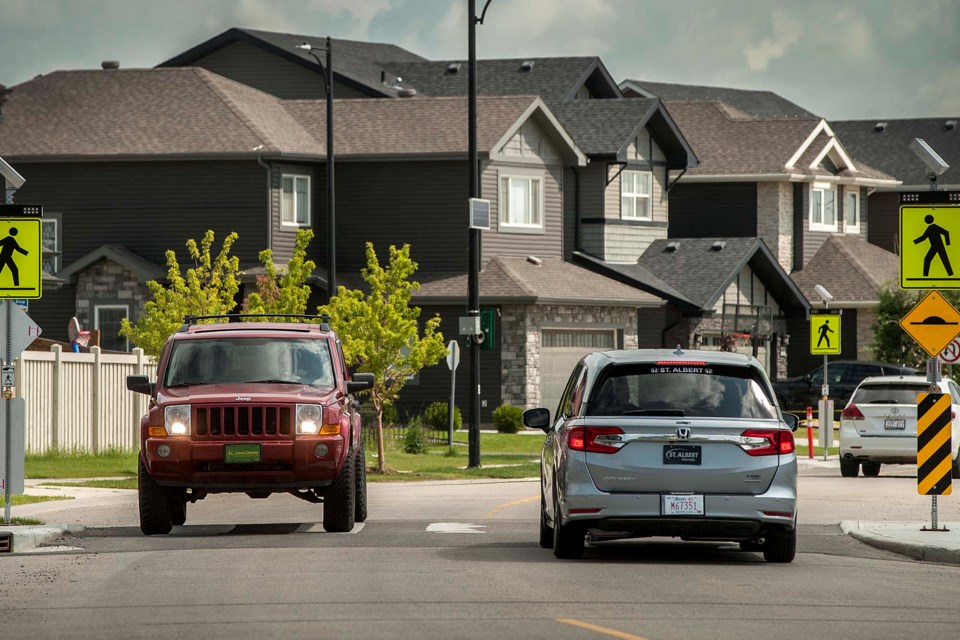Some St. Albertans are questioning whether proposed widespread changes to traffic speed limits will be enough, while others are hoping it will bring more consistency to the city’s roadways.
Eighteen people joined an evening Zoom call with city officials, traffic and research consultants on Sept. 17 to hear a presentation and ask questions before the changes are brought to council next year.
If approved, all local roads in neighbourhoods would be reduced from 50 km/h to 40 km/h. Select major roads, including sections of Sir Winston Churchill and Sturgeon Road, would see limits increased from 50 km/h to 60 km/h.
Elementary school zones would be replaced with playground zone hours from 8 a.m. to 8 p.m., and playground zones would be removed at Atwood Park, Forest Park and the southern portion of Deerbourne Park.
Council approved $20,000 in funding to hire Politikos Research to do public engagement to get feedback on the speed changes back in February. Implementing recommendations could cost about $245,000, down $120,000 from the original estimate due to pedestrian crossing improvements being completed this year, according to the city.
During the town hall, Dan Zeggelaar with ISL Engineering, the consultant group behind the traffic speed review study, said they used the Transportation Association of Canada (TAC) guidelines and risk factor methods when building the recommended speed changes.
The risk factor method is when the speed limit is determined by the risks associated with the physical design of the road and the expected traffic conditions that could affect drivers, like sidewalks, cyclists, driveways and crosswalks.
These factors can explain why a change in speed limit is needed, like reducing neighbourhood zones to 40 km/h, Zeggelaar explained. The consultant group also found a majority of drivers on collectors and local roads in St. Albert are travelling around the 40 km/h speed already, he said.
Dean Schick, city transportation manager, said the transportation department has been fielding a higher volume of calls from residents with concerns about speed limits over the last three years. Coupled with Zeggelaar's point, this could signal that most residents aren't comfortable with the current 50 km/h speed.
"By reducing speed limits and with strong compliance, it would be expected and fair to say that we could possibly see a reduction in collision occurrences," Schick said.
Rear-end collisions made up around 56 per cent of all incidents recorded between 2012 and 2018, followed by sideswipes at 14 per cent, according to St. Albert's speed review. In total, 6,288 collisions were recorded over that time period.
When it comes to applying playground zone rules to existing elementary school zones, Schick said keeping the 30 km/h limit in place until 8 p.m. is reasonable considering collisions have been recorded in school zones after hours, and children still use playground equipment after school.
For 40 years, Charles Grelli has lived on Larson Avenue off Giroux Road, where speeds are recommended to be reduced to 40 km/h from 50 km/h.
Grelli said he wouldn't be opposed to reducing the limit, as some drivers turn into the neighbourhood from the traffic lights on Giroux and "gun it" down the street. And drivers likely won't notice the 10-kilometre difference, he said.
"Are you going to need that much extra time that you would say no to that kind of change? I don't look at it as a great loss of time," he said.
Frank Sobolewski lives on Emery Crescent off Erin Ridge Drive, where road speeds were changed from 50 km/h to 40 km/h in 2019 as part of a city traffic calming program.
Changing the speed limit alone hasn't done enough, he said. Drivers speed down Erin Ridge Drive to bypass the St. Albert Trail on their way to the city's northwest, and higher speed bumps would force people to slow down, he said.
"It's good they've done something, but they need to do more. The little rises that they've put in here are not really speed bumps, and aren't adequately slowing down traffic, " he said. "We've still got way too high of a volume, and we still have people driving through here at excessive speeds."
Rob and Judy Hutchinson also live on Emery Crescent off Erin Ridge Drive.
The couple can see the radar speed sign from the corner of their property, meaning they can easily see how fast drivers are going as they pass. Before the changes, Rob said he would see cars flying down the road at 70 km/h. Now, they're hitting more in the 50 km/h range.
"It has lowered the speed limit, but not to what the legal limit is," he said. "There's almost nobody is going 40 (km/h) as they approach that sign, but as soon as they see the sign, you can see and hear them start to slow down."
Limiting all neighbourhood roads to 40 km/h would add more consistency for drivers, Rob said. Recently, he said he counted eight different speed zones driving from his home to the gym at Servus Place on a school day.
"You have to be paying attention because it depends on what day of the week it is and what time of day it is."
A blanket speed limit may add more consistency to the city's neighbourhoods, but Judy questioned whether it was necessary for all roads.
"Some of the neighbourhoods have wide-open streets, there's not a lot of traffic, the sightlines are good. So 40 (km/h) might be a little bit frustrating."
The city's online survey on traffic speeds ends on Oct. 2 at 11 p.m. Feedback will be considered before the recommendations presented to council in January 2021. Any additional input will be used to create a final presentation to council next February.
–with files from Sydney Upright




